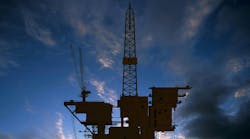Paula Dittrick
Senior Staff Writer
HOUSTON, May 6 -- Both onshore and offshore sequestration options are under study to find large capacity storage for carbon dioxide emitted from the use of fossil fuels, said panelists speaking May 6 at the Offshore Technology Conference in Houston.
Sally M. Benson of Stanford University said improved understanding of multiphase flow and trapping in CO2-brine systems is needed to predict the storage capacity of saline aquifers.
Daniel P. Schrag, a professor at Harvard University's Department of Earth and Planetary Sciences, believes deepsea sediments in 3,000 m of water could provide permanent offshore storage by gravitational trapping.
Sequestration of CO2 would keep it out of the atmosphere, where it could contribute to global warming, scientists say. Representatives of industry, academic institutions, and governments worldwide are working on carbon capture and storage technology.
Onshore sequestration
Benson is studying monitoring methods "to provide a quantitative assessment of the fate and transport of injected CO2" over time. Physical and chemical properties of the storage reservoir and seal are key to the permanent containment of sequestered CO2, she said.
Performance standards regarding leakage have yet to be established, Benson said. Detection methods include seismic monitoring and atmospheric flux monitoring. A recent experiment proved releases of sequestered CO2 are detectable and can be measured. More such testing is pending, she said.
Benson referred to the Big Sky Carbon Sequestration Partnership at Montana State University. Big Sky is one of seven US Department of Energy programs investigating carbon sequestration.
The public demands a better understanding of what might happen to CO2 injected into a saline aquifer, she said, calling monitoring a key element of any sequestration project.
"This interest is driven in part by concerns about long-term stewardship and liability. After the injection phase of the project is completed, and the wells have been abandoned, there are unanswered questions," Benson said.
Benson said unanswered questions include:
-- How long and how much monitoring is required?
-- If a leak is detected, what can be done to stop it?
-- Who is responsible for monitoring and potential remediation?
-- Can long-term liability be transferred to a shared risk pool?
-- Will state or federal governments assume long-term liability?
Offshore sequestration
Schrag is evaluating the potential for subsea CO2 storage in deepsea sediments.
"At high pressures and low-temperatures common in deepsea sediments a few hundred meters below sea floor, CO2 will be in its liquid phase and will be denser than the overlying pore fluid," he said. "The lower density of the pore fluid provides a cap to the denser CO2 and ensures gravitational trapping in the short term."
Thermal modeling and laboratory calculations show injected high-density liquid CO2—combined with its potential to form CO2 hydrates—will impede upward migration. He has yet to do any field tests on his calculations, but said he is working with Shell Oil Co. to develop a system that would enable field tests.
Schrag believes his proposed offshore sequestration will prove to be an "essentially a leak-proof method."
Contact Paula Dittrick at [email protected].

